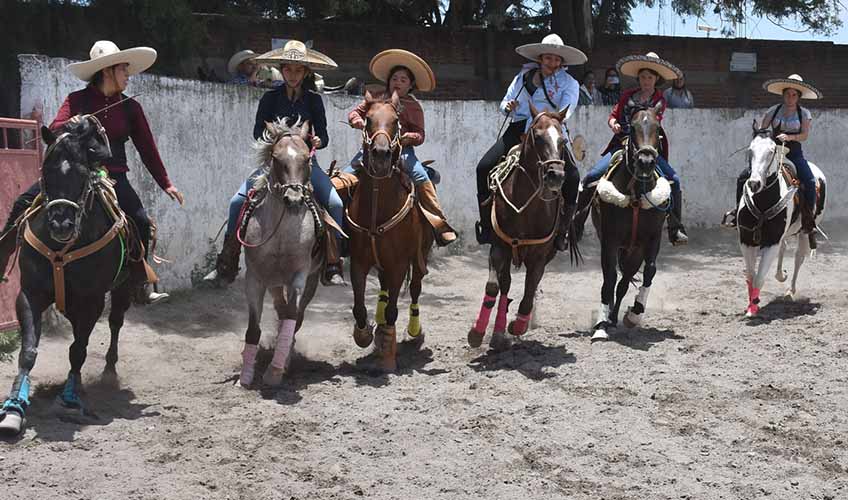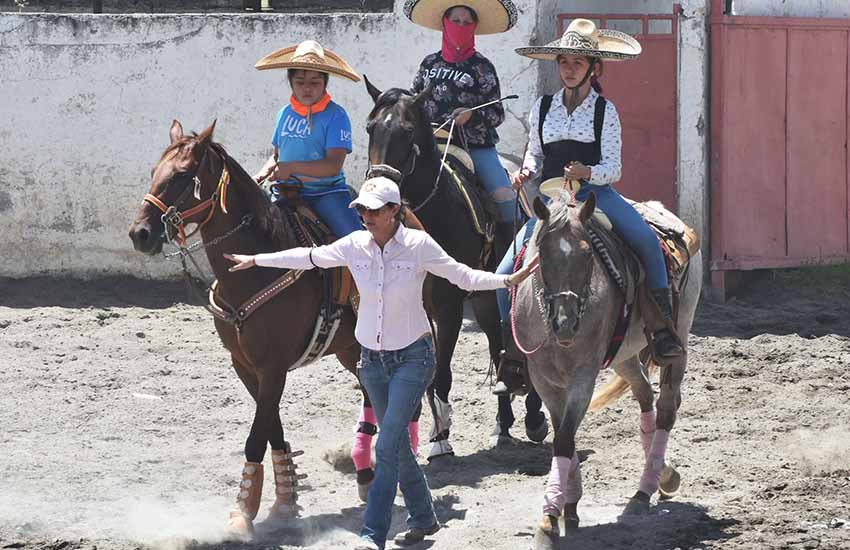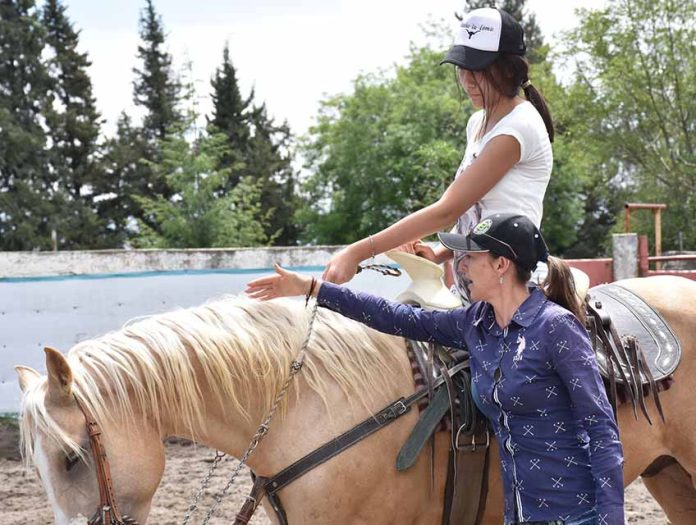Under the watchful eye of their trainer, four pairs of young women on horseback circle a small arena in Chipilo, Puebla, keeping alive a Mexican tradition that dates back to the Spanish colonial era.
When their captain, Fernanda Berra, calls out “uno,” they turn their horses toward the center of the arena and smoothly for a circle before breaking off again in pairs to perform the maneuver yet again.
In fact, they’ll perform this maneuver and several others again and again until they’re perfect — in hopes of someday taking part in an escaramuza charra, a traditional Mexican equestrian event for women.
The goal with this team, and with all teams, is to enter competitions. They’ll start with local ones, hoping to advance to state and, eventually, the national competitions, which are held in late October or early November.

“The name escaramuza (skirmish) comes from the Mexican army,” said Claudia Ivet Becerril Aragon, who has performed in escaramuza charra for 28 years and worked as a trainer for 10. “[These soldiers] were mounted on horses and were in the lead. They were in front of everything.”
The tradition came out of charrería — traditional Mexican rodeo — which has its roots in rural Mexico where haciendas had large herds of cattle. Part of the tradition involved competitions between haciendas that showcased a cattleman’s ability to rope and ride.
After the Mexican Revolution ended in 1920, the nation’s haciendas were broken up. Many owners, as well as the workers on these estates, moved to cities where they continued to ride and often met in informal competitions.
These competitions and the sport became formalized in 1921 with the formation of the National Charro Association. And in 1933, charrería was declared Mexico’s national sport. It’s also on UNESCO’s world list of intangible cultural heritage.
Charrería opened up to women sometime in the 1950s. While men perform individually, women perform in teams of eight.
The women wear colorful ruffled dresses and sombreros during competitions, a costume that honors the Adelitas, women who fought in the Mexican Revolution. The teams of women ride sidesaddle while performing intricate movements to traditional music. They do maneuvers that involve crosses and turns and forming circles.
“It takes two years for a team to be ready to compete and to perform decently at the lowest level of competition,” said Becerril, “and four years to be ready to compete at the national level.”
When Becerril wants the women to learn a new movement, she calls them to the center of the corral, called a lienzo, gesturing as she explains. For the cross maneuver, the women ride from opposite sides of the lienzo and weave their way past each other.
It all seems incredibly complicated to an outsider, but she somehow gets her point across and the women trot away as Becerril continues to call out instructions and encouragement.
Escaramuza charra is not an inexpensive sport. The women all wear the distinctive, large sombrero traditional to the sport that was originally made of straw but that these days, is often made of rabbit skin and embroidered with intricate designs. These can cost as much as US $2,000.
Then there are the beautiful dresses the women wear, costing between US $150 to US $250. Buying a horse runs anywhere from US $1,750 to US $7,500, and the animal’s food and maintenance can cost as much as US $3,000 a year.
It’s a beautiful and expensive sport. It’s also dangerous.

“There are many risks,” said Becerril. “It is considered an extreme sport. A person can fall, there are crashes at high speed. There can be fractures and even deaths. It is always dangerous to mount a horse; it is an animal.”
But, she added, “At the moment of the presentation, there is adrenaline. It makes one feel alive. One feels connected with the horse. It is a link. I think that contact with a horse makes one happy.”
“It is my passion,” explained 15-year-old Renata Mora López. “I love horses. It is a little dangerous, but I have no fear. None. It is like I have practiced all my life.”
Sixteen-year-old Emma Elizabeth Cilia García, who’s been participating for seven months, says it’s not only fancier than other sports, “there is more adrenaline, and it requires more discipline.”
Practices can sometimes last as long as four hours. “It is pretty rough sometimes,” she admits, “but it is worth it.”
For many of the women, including Becerril, escaramuza charra is a family affair, with mothers, aunts and nieces participating. Often, their fathers and uncles are participating in the male version.
Becerril says that after working together for hours over months and years, the women also form a close-knit unit, what she calls a charra family.
But, she acknowledges, that doesn’t always happen right away. It can be a challenge to keep the younger women involved long-term. She maintains an upbeat and patient demeanor during rehearsals, smiling and laughing often, but she admits to feeling frustrated at times.
“It is difficult to keep a team together because girls leave,” she said. “We will get to one point, learn the exercise and then someone says, ‘I am going to leave.’ You get to one point, and then you have to go back to the step before. It is a lot of work.”
At one recent practice, two new girls were having difficulty learning the maneuvers. “You see how it is with new girls?” she said. “We advance, and then we go back.”
Despite the challenges and frustrations, Becerril said she will continue to teach, and not just because she personally loves the tradition.
“If we do not continue, the sport will be lost,” she said. “It is very important for the culture of Mexico to continue with these traditions, to continue the traditions that the generations behind us have given us.”
It’s a tradition that she says is authentically Mexican.
“To see someone dressed in charro, you will identify that person as a Mexican,” she said.
Joseph Sorrentino, a writer, photographer and author of the book San Gregorio Atlapulco: Cosmvisiones and of Stinky Island Tales: Some Stories from an Italian-American Childhood, is a regular contributor to Mexico News Daily. More examples of his photographs and links to other articles may be found at www.sorrentinophotography.com He currently lives in Chipilo, Puebla.
